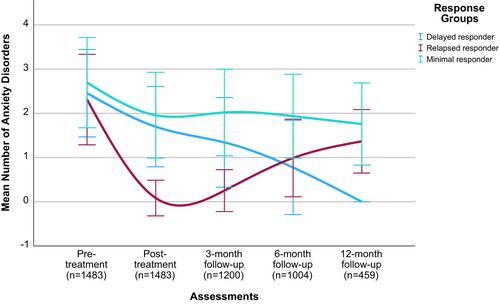Children and adolescents demonstrate diverse patterns of symptom change and disorder remission following cognitive behavioural therapy (CBT) for anxiety disorders. To better understand children who respond sub-optimally to CBT, this study investigated youths (N = 1,483) who continued to meet criteria for one or more clinical anxiety diagnosis immediately following treatment or at any point during the 12 months following treatment.
Data were collected from 10 clinical sites with assessments at pre-and post-treatment and at least once more at 3, 6 or 12-month follow-up. Participants were assigned to one of three groups based on diagnostic status for youths who: (a) retained an anxiety diagnosis from post to end point (minimal responders); (b) remitted anxiety diagnoses at post but relapsed by end point (relapsed responders); and (c) retained a diagnosis at post but remitted to be diagnosis free at end point (delayed responders). Growth curve models assessed patterns of change over time for the three groups and examined predictors associated with these patterns including demographic, clinical and parental factors, as well as treatment factors.
Higher primary disorder severity, being older, having a greater number of anxiety disorders, having social anxiety disorder, as well as higher maternal psychopathology differentiated the minimal responders from the delayed and relapsed responders at the baseline. Results from the growth curve models showed that severity of the primary disorder and treatment modality differentiated patterns of linear change only. Higher severity was associated with significantly less improvement over time for the minimal and relapsed response groups, as was receiving group CBT, when compared to the delayed response group.
Sub-optimal response patterns can be partially differentiated using variables assessed at pre-treatment. Increased understanding of different patterns of change following treatment may provide direction for clinical decision-making and for tailoring treatments to specific groups of clinically anxious youth. Future research may benefit from assessing progress during treatment to detect emerging response patterns earlier.


